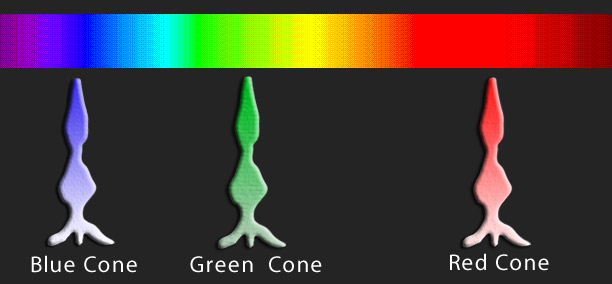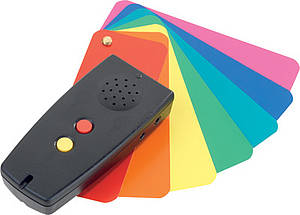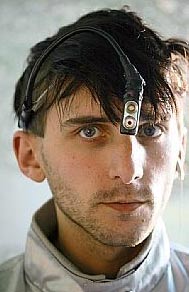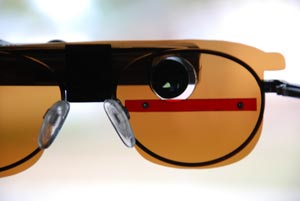Colorblindness and Achromatopsia
"People say to me, it must suck not to see colour. I'm
thinking, I've never seen it. So I don't know.' "
-Karl Schwonik, Award Winning Drummer.
Achromatopsia means without color. Most achromats are rod monochromats. Complete rod monochromats have no color vision. While incomplete rod monochromats may have small traces of specific colors when the light and glare are "just right."
Blue cone monochromatism is a second form of achromatopsia. Blue cone monochromats are incomplete achromats that retain the blue (S) cones, which are sensitive to short wavelengths like blue light. Since the brain must compare the signal from at least two types of cones to fully appreciate color, they still have limited color vision and may not see blue in the same way "normals" do. They may, however, see that blue objects stand out more distinctly.
In general, many incomplete achromats describe specific colors they feel they see better. We must remember that the ability to recognize a color may not indicate that the achromat see this color the way those with "normal" color vision do. It is important to understand that, if you have never seen in color, it is hard to morn the lack of color vision; it is simply the way your vision has always been.
More than Black and White
While we often describe the vision of complete achromats as seeing black and white or gray, the range of tones of gray when light is controlled can be quite stunning, like a fine black and white photograph.

The term gray, however, may have meaning to those of us with normal color vision by contrast with our color vision. Thus the term “gray” may not be as meaningful to an achromat.
“No one was going to convince me that everything in the world I knew to be so richly varied in shades of light and dark was all supposed to be called ‘gray’! To me, it seemed ridiculous to imagine that, for instance, a dark tree and a light colored flower would both be identified as ‘gray.’ If I could see – or if I had ever been able to see – any colors, then I might perceive the absence of color as gray.”
Living with Achromatopsia Edited Frances Futterman Achromatopsia Network
The Photoreceptors
Within the human retina, we have four photoreceptors: three types of cone receptors for red, green, and blue respectively plus the rods photoreceptors which do not detect color. In combination, these photoreceptors provide a sharp clear world of vivid colors, a panoramic view and the ability to see under a wide range of light from very dim light to bright sunshine.
The cone cells consist of three types, red or L cones (long wavelength), blue or S cones (short wave lenghth), and green or M cones (medium wave length). They are each sensititive to different portions of the spectrum of light. The various shades of color seen by most of us depend upon the brain's perception of signals from these three types of cones and the rods in the brain.
The diagram below shows how the three different types of cones are sensitive to different portions of the spectrum of light

The cone cells owe their ability to see different colors to the three different types of photopigments found in cone cells. Each type of cones (red, green or blue) is most sensitive to a different range of wavelengths or colors of light based on the type of chemical or opsin found in each of the three cone receptors.
Cone cells are very stable in bright light, but cannot function at very low levels of light. Cones are normally concentrated in the very center of our vision, the macula. Only cone cells exist in the fovea, the very center of the macula. In fact, only red and green cones are found in the fovea. The fovea normally provides our sharpest vision due to its structure and the high concentration of cones packed into this tiny area. Cones are found throughout the peripheral retina, but in lower concentrations.
The fourth type of photoreceptor, the rod cells, do not differentiate color. Rod photoreceptors contain a very light sensitive chemical, rhodopsin, which is unstable in bright light causing the rod receptors to become bleached out in bright light.
The graphic below shows the rainbow spectrum of visible light to a "normal".

The next graphic below shows how the rainbow-like spectrum of light above would appear to a complete rod monochromat with only rods functioning.

Rod cells are missing at the very center of our vision, but reach higher levels in the periphery of the retina. Rods help us see rich shades and tones of gray from black to white that we simply have no vocabulary to define.
Rods are connected in groups of cells that are very sensitive to motion in our peripheral vision. That is why we quickly detect a tiny flying insect to our side, but may fail to see the same insect when it is directly in front of us.
To understand what the achromat’s vision is like without the ability to detect all or most colors, one can imagine the beauty of a black and white photograph. We can appreciate the quality of the tones and shades that can be seen without “color.” Perhaps by being preoccupied by our sense of color, we non-achromats have failed to develop the vocabulary to describe all these tones and thus they all become “gray”. Achromats do not have the same preoccupation with color vision. If you have never experienced color you do not have something to miss. Color vision loss can be a day-to-day problem that required some strategies but is rather the major problem an achromat presents.
“Color is just not really a part of my life, except that I want my clothes to match and I want my kids’ clothes to match. I want to be socially acceptable color-wise.”
- Achromat Network Member
The quality of this image depends on the control of light. If we control the light, achromats may see this rich range of gray tones just as we can see a range of color tones. However, an achromat without adequate filtered lenses, will see a washed out image without the potential quality of the image.
The left image is washed out from the failure to use adequate filters. To see the image in the way shown on the right would require the use of dark filters in eyeglasses or contact lenses.

The quality of the image an achromat sees at any one point in time, however, depends on the level of lighting and the adaptation of the eyes.
Incomplete Achromatopsia
In incomplete forms of rod monochromatism, a very small amount of residual cone functioning may be present allowing the patient to see a trace of color vision in certain light conditions. The picture on the left shows how an incomplete achromat might see "a bit of red" in the right circumstances.

In patients with incomplete achromatopsia, selective filters may enhance the patient’s ability to see certain residual colors. For example, if a patient has some red cones still functioning, viewing through a red filter may enhance the ability to detect the color red.
We have used this frequently in helping achromatopsia patients become bioptic drivers. One typical patient, who had initially failed to become a bioptic driver was later able to be licensed after red filtered contact lenses were prescribed. Before the red filtered contact lenses were fit, he was unable to adequately see the brake lights light and detect traffic lights changing during driver's training. Later, we fit him with red central contact lenses. We did not suggest trying bioptics at that time owing to his prior difficulty. He returned on his own many months later, reporting that he could now see the brake lights and traffic lights and was also no longer overwhelmed by the light. He has now been a successful bioptic driver for many years.
In blue cone monochromatism, the blue cone and rod receptors are spared but the patient is missing the red and green cells. The patient has only rods and blue cone cells to function. These patients see some color in the blue spectrum. They may not see this as "blue" color but may see a blue colored object better than other colors. As filters are applied to control the glare, one must be careful to avoid selecting a filter that cancels out the patient’s residual blue vision. A dark red filter may block the blue light entering the eye reducing the blue cone monochromat's vision. A magenta filter, which allows some blue light to pass through to the retina, may be helpful.
Color Vision and Early Learning
Color vision may impact learning in a child if color-coding is over used and must be addressed with family and teachers. It may prevent an achromat from entering a specific occupation or driving with bioptics. It can cause them concern in shopping for clothes or paint. But, I find too often doctors fail to understand that if we control the light and provide low vision aids, most achromats function very well in the world and color vision is rarely listed as a major problem. For adults, their lack of color vision is simply the way their world has been all of their life.
As one achromat stated, "you do not mourn something you have never experienced." This is not to lessen the day-to-day problem of severe colorblindness.
In children, however, we must deal with the use of color in school. Young children face a world where they are constantly asked to make learning related judgments based on color vision. They have not developed the strategies that adult achromats use to compensate. Children may also be stigmatized by well meaning family members frequently asked them to identify a color.
Strategies of the Colorblind
Achromats often develop their own strategy that best works for them. The color of clothing is often important. There are many ways to deal with clothing to avoid embarrassment. Take a friend with you to buy clothes, paints and other color-based items. If not, ask a sales person for color selection assistance. Clothes can be organized in several ways. Clothes can be arranged in separate parts of the closet. Clothes can be marked with codes sewn inside. Some avoid buying clothes in different colors that look the same to the patient. For children, keep it simple with blue jeans that will match most clothes. Having a parent or spouse quickly check for color clashes can be helpful. Shoes can have a label of the color inside. Socks can be clipped together before washing to avoid the difficulty of sorting them by color.
An artist may work in charcoals rather than color pastels. A photographer can work in black and white rather than color.
Handheld Color Detecting Devices
Today small electronic devices are available that allow the detection of color for specific activities. These can be used to check the color of clothes. One example  of these devices is the Colorino. It is a color identifier designed that can be used by achromats. Colorino can identify more than 150 colors, announcing them in a clear voice. It is available in 20 different languages, including English and Spanish. Its light probe function can detect sources of light and differentiate between natural and artificial sources. It can be connected to other electronic devices. Other features include a hole for inserting a ribbon to carry the device around the neck. The unit comes with a carrying case, and instructions in large print, braille, and audiocassette. It costs about $200.
of these devices is the Colorino. It is a color identifier designed that can be used by achromats. Colorino can identify more than 150 colors, announcing them in a clear voice. It is available in 20 different languages, including English and Spanish. Its light probe function can detect sources of light and differentiate between natural and artificial sources. It can be connected to other electronic devices. Other features include a hole for inserting a ribbon to carry the device around the neck. The unit comes with a carrying case, and instructions in large print, braille, and audiocassette. It costs about $200.
The Eyeborg: Hearing Colors
Neil Harbisson is a twenty-eight year old artist, and the first to employ the Eyeborg system to help him associate colors with sounds. Harbisson has complete achromatopsia, an obvious concern for a young artist. The color  sensor in the Eyeborg detects colors, and then convert them to sounds, which based on how high or low the pitch of the sound can provide him with a way to determine the color. Harbisson reported that “when I paint, it is as if I am composing music on a canvas.” His experience as a pianist from a young age has helped him assimilate music and color.
sensor in the Eyeborg detects colors, and then convert them to sounds, which based on how high or low the pitch of the sound can provide him with a way to determine the color. Harbisson reported that “when I paint, it is as if I am composing music on a canvas.” His experience as a pianist from a young age has helped him assimilate music and color.
In October 2003, during his second year at Dartington College of Arts, Harbisson he attended a lecture on cybernetics by Adam Montandon, a Plymouth University student. From that moment Neil and Adam started working on the Eyeborg project.
The Eyeborg has now allows Neil to work in color. Prior to the Eyeborg entering his life, his works were all in black and white, the medium often being charcoal. Today, Harbisson wears the system full time and has a new sense of how to apply color to his art.
In art and other occupations, where color vision may be more critical, this system may have a future role.
The video below is from The Discovery Channel's DailyPlanet, and is shared through YouTube.
Color Enhancing Filters
Special filters can be used to enhance color vision in many incomplete achromats. If a patient sees some traces of red, placing a red filter over one or both eyes can often enhance detection. This will not work for a truly complete achromat. Knut Nordby, an achromat and scientist described discovering this concept:
“When I was about 15, I discovered, quite by accident the use of a coloured filters for analyzing different hues. We had a large salad bowl made of transparent red-coloured plastic. One day when holding the bowl to and fro, I could make the red-coloured pattern change from light to dark.”
Knut Nordby, Vision in a complete achromat: a personal account Night Vision R.F. Hess, L.T. Sharpe & K. Nordby
Subtraction Filters
In our practice, we use filters to help our achromat bioptic drivers confirm traffic signal lights. Some achromats learn to  determine the light signal by position. In most localities, the red is on top and green below. When approaching the signal from a few blocks away, it may be difficult to determine the light position of the light. Also, if the sky is bright behind the traffic signal, the detection of the light may be more difficult. A small strip of red filter can be used to quickly verify the color.
determine the light signal by position. In most localities, the red is on top and green below. When approaching the signal from a few blocks away, it may be difficult to determine the light position of the light. Also, if the sky is bright behind the traffic signal, the detection of the light may be more difficult. A small strip of red filter can be used to quickly verify the color.
A red filter will enhance seeing the a red light. A green traffic light will be blocked by the red filter and turn completely dark. This does not require any color vision. This concept is how a digital camera or color scanner detects color. Filters are placed before each receptor component that remove all the light except a specific color. Thus, if the receptor fires it must be that color.
